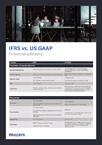
IFRS vs US GAAP
The US GAAP, developed by the Financial Accounting Standards Board (FASB), is the predominant reference in the United States and is mandatory for publicly traded companies in this country. This framework is based on specific principles that seek to provide consistency and comparability in the presentation of financial statements, reflecting the conviction that accounting transparency is essential for informed decision-making. The US GAAP regulatory framework may be more precise in how it is applied, compared to other regulatory frameworks.
On the other hand, the IFRS, developed by the International Accounting Standards Board (IASB), has gained increased adoption globally. These standards are chosen by many companies in Europe, Asia, and Latin America, allowing for homogeneity in financial reporting across different jurisdictions. This framework is applied in more than 120 countries. Adoption and presentation are more flexible on various topics, such as revenue recognition based on an identification method.
The choice between US GAAP and IFRS is not only based on geographic location, but also on the company's global strategy and its commitment to international financial transparency. These dual regulations reflect the complexity and interconnectedness of today's financial markets, where comparability and understanding between different accounting systems are essential to facilitate investment and business decision-making on a global scale.
That is why companies must plan in the future for the adoption of one regulation or another according to the scope of their operation. Planning for future adoptions is critical for providing information to users of financial information and for decision-making.
At Financial Advisory we have the knowledge and experience in IFRS and USGAAP to help our clients. Download the document and see a comparative between these frameworks.
Want to know more?


